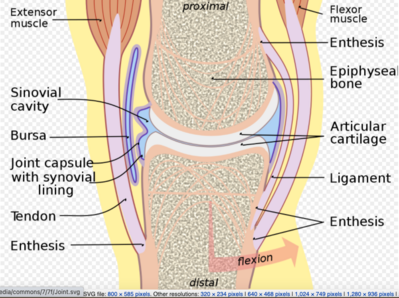Synovial Joints
Original Editor - Lucinda hampton
Top Contributors - Lucinda hampton and Joao Costa
Introduction[edit | edit source]
Histologically the three joints in the body are fibrous, cartilaginous, and synovial. Synovial joints are the most common type of joint in the body (see image 1.).
A key structural characteristic for a synovial joint that is not seen at fibrous or cartilaginous joints is the presence of a joint cavity. The joint cavity contains synovial fluid, secreted by the synovial membrane (synovium), which lines the articular capsule. This fluid-filled space is the site at which the articulating surfaces of the bones contact each other. Hyaline cartilage forms the articular cartilage, covering the entire articulating surface of each bone. The articular cartilage and the synovial membrane are continuous. A few synovial joints of the body have a fibrocartilage structure located between the articulating bones. This is called an articular disc, which is generally small and oval-shaped, or a meniscus, which is larger and C-shaped.[1][2].
Synovial joints are often further classified by the type of movements they permit. There are six such classifications: hinge (elbow), saddle (carpometacarpal joint), planar (acromioclavicular joint), pivot (atlantoaxial joint), condyloid (metacarpophalangeal joint), and ball and socket (hip joint).[1]
Nerve Supply[edit | edit source]
Sensory and autonomic fibers innervate synovial joints.
The autonomic nerves are vasomotor in function, controlling the dilation or constriction of blood vessels.
The sensory nerves of the articular capsule and ligaments (articular nerves) provide proprioceptive feedback from Ruffini endings and Pacinian corpuscles. Proprioception of the joint permits reflex control of posture, locomotion, and movement. Free nerve endings convey pain sensation that is diffuse and poorly localized. The articular cartilage has no nerve supply.
Two general principles apply to synovial joint innervation:
- Hilton’s law states: Articular nerves supplying a joint are branches of the nerves that supply the muscles responsible for moving that joint. Hence irritation of articular nerves causes a reflex spasm of the muscles which position the joint for the greatest comfort. These nerves also supply the overlying skin, providing a mechanism for referred pain from joint to skin.
- Gardner’s observation: When part of the articular capsule that is tightened, by contraction of a group of muscles, they receives nerve supply from the same nerves that innervate the antagonist muscles. This relationship provides local reflex arcs that stabilize the joint[1].
Sub Heading 3[edit | edit source]
Resources[edit | edit source]
- bulleted list
- x
or
- numbered list
- x
References[edit | edit source]
- ↑ 1.0 1.1 1.2 Juneja P, Hubbard JB. Anatomy, Joints. 2018 Available: https://www.ncbi.nlm.nih.gov/books/NBK507893/ (accessed 20.6.2021)
- ↑ OSE Synovial joints Available:https://open.oregonstate.education/aandp/chapter/9-4-synovial-joints/ (accessed 20.6.2021)







